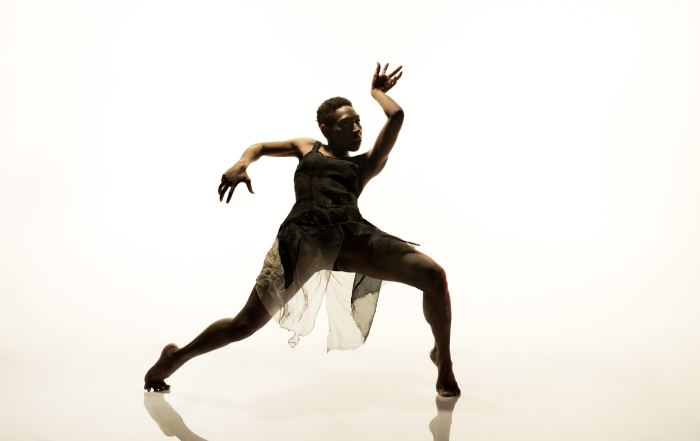The program begins with the sombre, disturbing “Macq”, a powerful exploration of the impact of Lachlan Macquarie on Australia from a black perspective. The strong and aggressive choreography (Jasmin Sheppard) reflects the choreographer’s dedication to telling the uncomfortable truth and revealing the physical suffering and emotional damage inflicted on the D’harawal people under Macquarie’s governance.
A long white table, both a symbol of the land and of white domination, conveys at once the bitter irony of the British administration. The bizarre anomaly of Macquarie “generously” inviting the Aboriginals to picnic on their own land is satirised through the nightmarish costumes, distorted movements of the ensemble and voice-over. The real intentions of Macquarie (Daniel Riley), however, are revealed when sitting in assumed authority on a white chair at one end of the table he tries to set boundaries for a D’harawal man (Beau Dean Riley Smith) who squats on an allotted white chair at the opposite end.
Tension escalates over the ownership of the land as the two dancers circle and stalk each other along the tabletop. Eventually, war is declared by Macquarie and the tragic consequence for the D’harawal is expressed in the incredibly powerful elegiac “Bodies in the Trees”. The repeated lifting and lowering of the dancers’ bodies and their eventual slow fall to the ground creates a sense not only of appalling loss but also of the senselessness of violence. The mourning returns us to the opening sequence in which Nicole Sabatini so poignantly expresses the intense longing of the grief stricken to feel again the living touch of her dead husband.
While “Macq” is both a condemnation of brutal suppression and a memorial to the Appin Massacre that occurred in 1816, the performance affirms the resilience of the D’harawal. In creating her story Shepperd consulted with direct descendants of the D’harawal, Frances Bodkin and Gavin Andrew.
“Migagan”, choreographed by Beau Dean Riley and Daniel Riley, celebrates kinship and thereby affirms the connections that give Aboriginal people such resilience. The story has significance for the two dancers and cousins from the Wiradjuri nation, who can trace their familial connection back to their great-great-grandfather who lived on Dubbo Reserve in the early 1900s. With the help of Aunty Lyn and Auntie Dy the two dancers learned about the five levels of the matrilineal totemic system, Nation, Moiety, Clan, Family and Individual, and transposed their knowledge into an exciting, warmly coloured, living tapestry of connection.
Visually the setting tells the audience its story. A branch with two major offshoots and several twigs, reminiscent of veins, and bearing two leaf-like sheaves of emu feathers, descends to the accompaniment of cockatoo shrieks and remains centre stage overhanging the action. To the side, three ancestral beings, dimly perceived at first but gaining definition, rise from a crouching posture to anoint themselves with white ochre establishing the spiritual connection between land and the social group, bonded by language, custom, lore and law.
As the group grows over time – the young, lovers, the old – two more branches descend beneath which mesmerising wave upon wave of ensemble upbeat movement suggest the long and complex legacy of Aboriginal inheritance, entwining, dispersing, recombining, that makes up the past. In a last and powerful moment, a single sheaf descends and beneath it a single figure (Beau Dean Riley Smith) steps into the spotlight. An individual who, aware of his identity, carries the shared past into the present, and will carry it into the future, and while a separate entity is never without a larger, warmer context.
The third performance, “Nyapanyapa”, choreographed by Stephen Page, honours an individual, the acclaimed Yolgnu artist Nyananyapa Yunupingu, telling of her art journey through movement, voice and appropriately, a remarkable backdrop featuring Jacob Nash’s brilliant re-creations of her paintings. Wonderfully imaginative the performance opens with the artist’s own remembered account of being mauled by a water buffalo in 1975.
The scrambled voice-over and the anthropomorphism of the angry buffalo (Waangenga Blanco), the dogs, emus and eucalypts establish that we are inhabiting Nyapanyapa’s inner world. A fanciful realm in which bush apples, seashells and nibblets, are invested with an energy and depicted with lightness and rhythm well-matched by the vigour and freshness of the dancers. The five separate interludes that make the whole is integrated by Elma Kris as Nyapanyapa, whose combination of almost shyness with authentic gesture, make her an ideal choice for the role of this unpretentious and distinctive printmaker and painter.
It is difficult to choose which of the various scenarios has the most impact. The re-creation of the rather whacky, boldly orange “Bird, Frog, Blue-tongue Lizard and Turtle” print is matched by the high-spirited, mischievous ensemble of dancers or the moment of deep peace in “Soul of Spirit” (Waangenga Blanco, Yolanda Lowatta)? Or perhaps the intriguing “Lost Wendys” (Wendy is Nyapanyapa’s English name) as ten delicately clad dancers appear and disappear behind and between huge mop-headed black cutouts? Or perhaps the powerful conclusion as Nyapanyapa’s face emerges to gaze at us all over a rocky land magically sculpted from the bodies of the supine dancers?
Once again the stunning collective that is Bangarra has awakened in its audience a consciousness of the spiritual depth of its First Nation and the possibility of a future Australia as a safe and sacred place. The remarkable impression made by OUR Land Peoples Stories is made possible not only by fresh, inspired choreography and the uniformly accomplished and committed dancers, but also by the amazingly inventive creatives.
Jennifer Irwin has excelled herself in the sheer number and imaginativeness of the 300 costumes, the distinctive Bangarra soundscape, originated by the late and beloved David Page, is carried on by Paul Mac (“Macq”) and Stephen Francis (“Nyapanyapa”), lighting design (Matt Cox) ably supports and enhances both the story, and also the sets of Jacob Nash, who must receive a special mention for the unforgettable “Nyapanyapan”.





